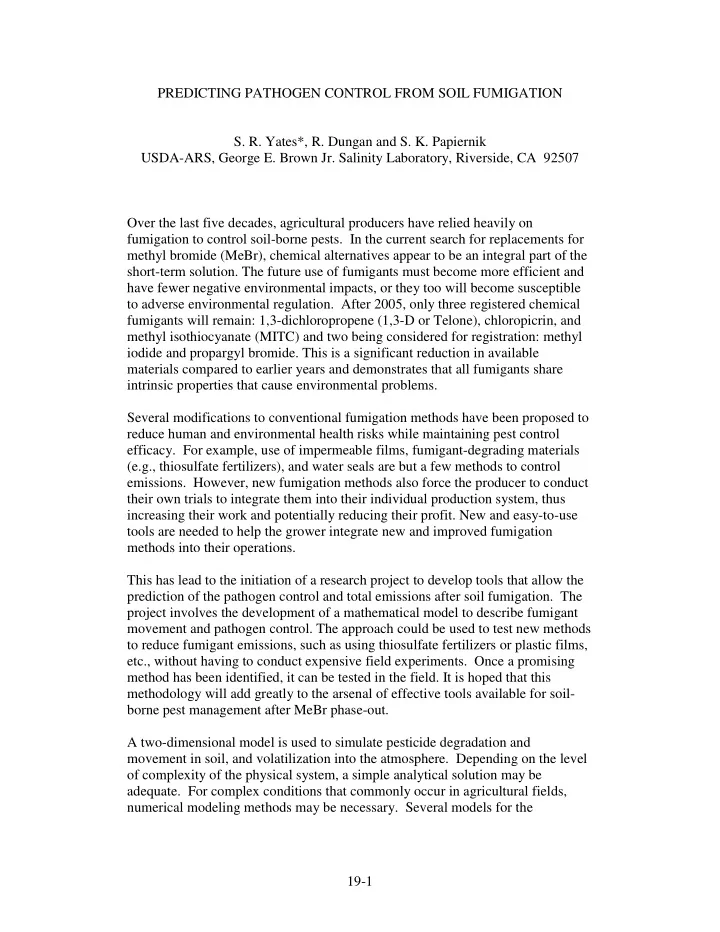

PREDICTING PATHOGEN CONTROL FROM SOIL FUMIGATION S. R. Yates*, R. Dungan and S. K. Papiernik USDA-ARS, George E. Brown Jr. Salinity Laboratory, Riverside, CA 92507 Over the last five decades, agricultural producers have relied heavily on fumigation to control soil-borne pests. In the current search for replacements for methyl bromide (MeBr), chemical alternatives appear to be an integral part of the short-term solution. The future use of fumigants must become more efficient and have fewer negative environmental impacts, or they too will become susceptible to adverse environmental regulation. After 2005, only three registered chemical fumigants will remain: 1,3-dichloropropene (1,3-D or Telone), chloropicrin, and methyl isothiocyanate (MITC) and two being considered for registration: methyl iodide and propargyl bromide. This is a significant reduction in available materials compared to earlier years and demonstrates that all fumigants share intrinsic properties that cause environmental problems. Several modifications to conventional fumigation methods have been proposed to reduce human and environmental health risks while maintaining pest control efficacy. For example, use of impermeable films, fumigant-degrading materials (e.g., thiosulfate fertilizers), and water seals are but a few methods to control emissions. However, new fumigation methods also force the producer to conduct their own trials to integrate them into their individual production system, thus increasing their work and potentially reducing their profit. New and easy-to-use tools are needed to help the grower integrate new and improved fumigation methods into their operations. This has lead to the initiation of a research project to develop tools that allow the prediction of the pathogen control and total emissions after soil fumigation. The project involves the development of a mathematical model to describe fumigant movement and pathogen control. The approach could be used to test new methods to reduce fumigant emissions, such as using thiosulfate fertilizers or plastic films, etc., without having to conduct expensive field experiments. Once a promising method has been identified, it can be tested in the field. It is hoped that this methodology will add greatly to the arsenal of effective tools available for soil- borne pest management after MeBr phase-out. A two-dimensional model is used to simulate pesticide degradation and movement in soil, and volatilization into the atmosphere. Depending on the level of complexity of the physical system, a simple analytical solution may be adequate. For complex conditions that commonly occur in agricultural fields, numerical modeling methods may be necessary. Several models for the 19-1
volatilization boundary condition are available to describe laboratory or more complex field conditions (i.e., volatilization coupled to atmospheric processes). The soil distribution and viability of plant pathogens is predicted using the concentration-time ( CT ) concept (Hemwall, 1959, Wang and Yates, 1999). t ∫ = CT ( x , y , t ) C ( x , y , t ) dt (1) 0 Predictions of pathogen control are possible once a relationship has been found between the pathogen concentration, C path ( x , t ) and CT(x,t) , that is [ ] = C path ( x , y , t ) f CT ( x , y , t ) (2) where f is an unknown functional relationship. The behavior of the relationship between CT and mortality is well known. For example, Figure 2 shows the relationship for barnyardgrass ( Echinochloa crusgalli ) and CT found during a recent experiment using propargyl bromide. It is clear that little control occurs for CT < 75 mg hr kg -1 and complete control for CT > 200 mg hr kg -1 . 100 Propargyl Bromide 80 Mortality (%) 60 40 Barnyardgrass Seed 20 ( Echinochloa crusgalli ) 0 0 100 200 300 400 Concentration-Time (mg hr/kg soil) Figure 1. The mortality of barnyardgrass seed as a function of exposure to propargyl bromide. To determine the accuracy of the prediction method, an experimental system was developed that consists of a 2-D soil cell with a surface-mounted flux chamber for measuring volatilization (Figure 2). The flux chamber has several sections, so that changes in the volatilization rate across the soil surface can be measured. This will be especially important for drip and bedded application systems. The 19-2
cross sectional area of the soil cell is approximately 0.6 x 0.6 m so that typical agricultural methods can be simulated. An array of sampling ports placed in a radial pattern away from the injection port will be used to determine soil concentrations. Schematic of Soil Cell Flux Chamber Outlet Inlet 5 cm 30 Sampling Soil Block Port 0 -30 cm -30 cm 0 30 Figure 2. Dimensions and sampling ports for 2-D soil cell. The pathogen survivability from a preliminary laboratory experiment will be compared to values simulated using a simple analytical solution for fumigant diffusion in soil. The model parameters for fumigant diffusion in soils were determined independently from the measured soil concentrations. A comparison of these parameters with optimally fitted parameters will be provided. References Hemwall, J.B. A mathematical theory of soil fumigation. Soil Science. 88:184- 190. 1959. Wang, D. and Yates, S.R. Spatial and temporal distributions of 1,3- dichloropropene in soil under drip and shank application and implications for pest control efficacy using concentration time index. Pesticide Science . 55:154-160. 1999. 19-3
Recommend
More recommend